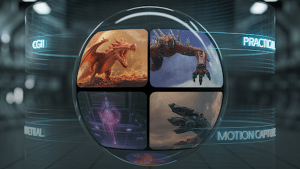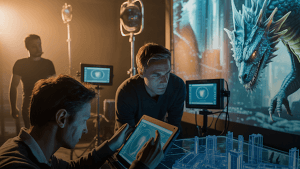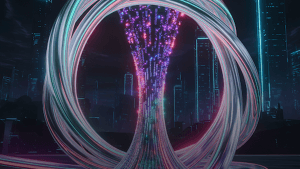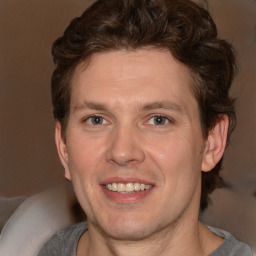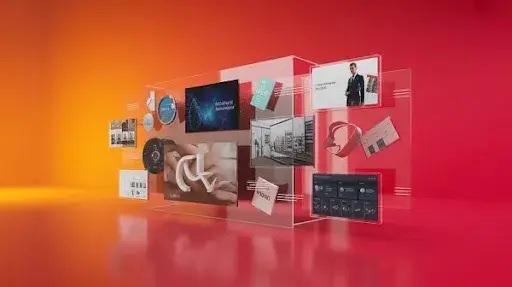Special effects, SFX or simply FX, are the spectacular effects that add magic to a movie or a video. These effects include explosions, creature transformations, futuristic environments, digital de-aging, etc.
SFX makes the simplest of scenes impossible to forget due to the numerous ways in which they can be captured on camera. Special effects and Visual effects (VE) are skill sets that every filmmaker, animator, or movie lover should understand, simply due to how fast technology is growing and changing.
We will examine the history of world-class visuals, from Prolific Studio to modern-day filming equipment and computers, and the types of special effects used.
What Are Special Effects (SFX)?
Special effects, SFX for short, combine various techniques to create illusions or phenomena in a movie that normal filming methods cannot attain.
These effects allow impossible scenes like flying superheroes, collapsing buildings of alien creatures to be captured in a vividly realistic manner, making special effects essential.
Every genre, such as science fiction, action, fantasy, and even horror, has universal special effects in modern cinema.
From the special effects standpoint, there are main two categories: practical effects and digital effects.
Some examples of practical effects include pyrotechnics, animatronics, and fog or simulated rain atmosphere effects like prosthetic makeup. These are done live on set and interact with the actors and environments.
On the contrary, effects produced or completed in post-production, such as computer-generated imagery, compositing, or motion tracking, are digital. This includes anything from green screen removals to placing digital creatures and crowds.
Anyone working in the entertainment industry should understand special effects. Filmmakers need to budget productions while also ensuring the safety and experience of the audience, which is why animators and producers rely on SFX.
Practical effects and miniatures trump real puppets due to cost and better reactions from the actors to the practical effects. Plus, practical effects often receive more genuine reactions from actors, thus enhancing performances on-screen.
Prolific Studio, for instance, combines physical effects with cutting animation and VFX workflows. Engaging, cinematic visuals for games, advertising, and films are produced through 2D and 3D animation services, which are enhanced by the realism of practical effects.
Today, the storytelling power of special effects is no longer limited to large budget productions; it can be utilized by any creator who wants to bring their imagination to life visually.
The Meaning and Evolution of SFX
Special effects are a concept that started with the early days of film. An era in which creativity was technologically constricted. The Icon of special effects is French illusionist and filmmaker Georges Méliès.
He created the famous movie A Trip to the Moon, which illustrated the incredible techniques of double exposure, substitution splices, and hand-painted frames.
While creating this film, he devised a technique of starting and stopping the camera, which allowed objects to appear, disappear, or even transform. This was the launching pad for years and years of cinematic wonder.
The evolution of its special effects paralleled the evolution of the film industry. In the silent film era, filmmakers used trick photography, optical illusions, tiny sets, and other in-camera magic.
By the mid-20th century, animatronics, complicated rigs, and physical gags had become integral to the film industry due to advancements in mechanical engineering, astounding viewers everywhere.
The two following decades experienced a renaissance of practical effects with the release of films like Star Wars, Alien, and The Thing.
These movies proved that amazing illusions could be crafted with traditional methods like puppetry, pyrotechnics, and forced perspective, rather than computers—and they began a revolution.
However, the digital boom of the 1990s brought about the heavier use of CGI and digital effects. Jurassic Park set the new standard in 1993 by merging animatronic dinosaurs and CGI, forever changing how audiences viewed films.
Yet, instead of making practical effects obsolete, this evolution encouraged a hybrid approach. Today, practical and digital effects are combined to produce highly realistic and emotionally resonant visuals.
At Prolific Studio, we honor this legacy by incorporating digital elements into traditional art forms. Our designers treat environments with care, ensuring imaginary places feel grounded when viewed through the lens of real life.
With our expert special effects, 2D and 3D Animation, and Blender services, we continue to respect the long history of SFX for the ever-evolving demand for spectacle and the ability to transform sustainably without changing its roots.
Read also: Top 10 Free 3D Modeling Software Tools for Creators in 2025
Special Effects vs. Visual Effects (SFX vs. VFX)
While often used synonymously, Special effects (SFX) and visual effects (VFX) describe different workflows in the filmmaking process. Acknowledging the distinction is crucial for animators, filmmakers, and production crews to plan, budget, and manage schedules efficiently.
Special effects (SFX) are tangible effects executed during the movie’s shooting. These incorporate prosthetics, animatronics, explosions, squibs, fake meteorological phenomena, transformations, makeup, and mechanical rigging to simulate environmental changes.
Because the cameras can capture the effects without any post-production alterations, SFX is often praised for its realism and evokes genuine reactions from actors.
VFX is digitally created after filming throughout post-production. CGI characters, green screen composites, matte paintings, and digital set extensions are examples of VFX. With VFX, filmmakers can imagine freely and realize their fantasies without incurring the risks or costs of doing them practically.
Additionally, by means of keyframing and physics simulation, control can be exerted over details, colors, and movements of the imagery.
Because of the developing digital tools that VFX offers, actors can be de-aged virtually, massive battle scenes can be simulated, and characters can be digitally placed in created locations. But rather than one replacing the other, modern productions increasingly use both SFX and VFX together.
For example, an explosion (SFX) might be enhanced with digital debris and fire trails (VFX), resulting in a highly immersive final shot.
Prolific Studio embraces this hybrid approach in our creative workflows. Our 3D animation services and game animation services blend VFX tools with real-world references, ensuring a visually consistent and technically sound final product.
Whether enhancing a live-action scene or animating an entire game environment, we understand how to use both types of effects effectively to deliver maximum visual impact.
Common Examples of Each
Understanding the tangible differences between special effects (SFX) and visual effects (VFX) is easiest when we look at real-world examples from film and animation.
Special effects are physical, performed on set during filming. These consist of timeless works such as blood squibs for simulating bullets, breakaway glass for stunt safety, and fog machines for dramatic or weather-related effects.
One of the well-known examples of practical SFX is the alien bursting out of the chest in the movie Alien (1979), where animatronics alongside real blood packs created shockingly bone-chilling moments.
Fog rolling into a horror film scene or a carefully controlled fireball explosion in an action flick also falls under SFX.
As an example of VFX, CGI monsters are seen in movies like Pacific Rim and Godzilla, fantastical worlds such as Pandora in Avatar, or digital doubles for stunt doubles in superhero films.
A well-known example is the de-aging of performers in The Irishman, where visual effects professionals crafted faces for each frame using artificial intelligence and CGI.
Some effects straddle the line between the two. Speaking of VFX and SFX, an example is the vehicle and explosion props used in the movie Mad Max: Fury Road, which were enhanced with digital flames and rubble. These two methods provide unparalleled realism and polish to the movie.
At Prolific Studio, we understand the importance of using both techniques cohesively. Our 2D and 3D animation services often integrate SFX elements like animated dust, fire, or debris, and elevate them using digital simulations.
In our game animation services, physical inspiration is transformed into responsive, immersive visuals that perform in real-time environments. These examples illustrate not just technical execution but also the strategic choices that define cinematic storytelling.
Types of Special Effects
Special effects encompass several major categories, all of which serve to create visual deception believably. These effects range from mechanical, optical, and pyrotechnics to makeup, prosthetics, and weather effects.
Each effect is unique regarding tone, environment, or even the scene’s action. These effects come together harmoniously to serve the different storytelling objectives of filmmakers and studios.
Consider mechanical effects, for example. They concentrate respiration within an enclosed volume, like a room, where enacting motion causing destruction and interacting with the surrounding world occurs.
The effects employ animatronics, hydraulics, and props to effect crashes. On the other hand, optical ones use the camera and/or lens to create an illusion.
The optical realm includes double exposure, rear projection, and matte painting. Pyrotechnics can be extremely explosive and add life to an action scene, but do need to be monitored closely.
The transformation and injury simulation of creatures can be done using aghast and prosthetic weather effects. Make it snow or rain for an entirely new dimension while combining prosthetics that age the actor wearing the makeup.
Minimal post-production aid can be achieved with careful mastery of the categories above, working hand in hand.
At Prolific Studio, we take a hybrid approach—using these foundational SFX categories as inspiration for digital equivalents in our 2D animation services, 3D animation services, and game animation services.
A scene some action might feature mechanical destruction with the help of digital simulations, which have a physics engine, or weather situations can be rendered in real-time using particle systems.
Our expertise makes sure that physical or digital, the result always feels like it’s part of the world, lifeworld, and evokes the appropriate emotions.
Let’s now explore each type in detail, starting with mechanical effects.
Mechanical Effects
Mechanical, physical, or practical effects are special effects in motion picture filming. They use real-life-made machines with motors, controlled systems to achieve movements that can, in a scene, show actions like destruction, collisions, or interactions with other items.
Everything from simple rigs that make a set shake during an earthquake to highly sophisticated animatronics that bring to life creatures or robots.
The artistry in mechanical effects includes, but is not limited to, the artistry of mechanic design included along with the artistry of timing, execution, synchronisation of the effects, and without computer designing.
The original Jurassic Park is one of the most recognizable films to use such mechanical effects, which included life sized animatronic dinosaurs that Stan Winston’s team brought to life for actors on set to interact with.
The rest gave more lifelike performances, and audiences were astonished, even still today, many decades later. Likewise, The Terminator and Aliens are other films that used mechanical puppetry to achieve unforgettable sci-fi horror moments. The grounded nature of mechanical effects allows for far more visceral and raw storytelling.
Mechanical effects also include breakaway props, collapsing buildings, rain rigs, and even gimbals that simulate aircraft turbulence. These are designed to function in real time during filming and must be highly reliable and safe.
Their biggest advantage is that they’re captured in-camera, reducing reliance on post-production and preserving the director’s vision.
At Prolific Studio, we draw inspiration from mechanical effects to develop realistic movement and destruction in our 3D animation services and game development services.
For instance, we digitally replicate the physics of a collapsing structure or simulate vehicle mechanics for in-game cinematics.
By combining real-world references with digital accuracy, our team delivers effects that feel weighty, responsive, and believable—enhancing the visual and emotional impact of every project.. They’re used to simulate movement or destruction.
Optical Effects
Performing images through optical props techniques, such as a camera and film roped props, will not work for basic tools, such as mechanical tools, which are a type of effect.
These can be created via camera magic or after filming with film editing. Unlike mechanical effects, where props and setups are engineered components, illusionary optical effects employ light, lenses, and projection on a film medium to alter perception.
Back then, some common forms of optical effects included double exposure, rear projection, and matte paintings. The technique of Double exposure is especially popular in scenes where a spirit appears or people reminisce, as it allows multiple images to overlap with one another.
Rear projection provides motion footage for certain acts in a film; for example, scenery like landscapes can be shown in the background when a vehicle is in motion. Expanding the scene by combining it with a photograph of the actual scene requires constructing a detailed background painted on glass or canvas; this is referred to as matte painting.
All these forms of effects were critical in the making of Metropolis (1927), The Wizard of Oz (1939), and Citizen Kane (1941).
With the rise of digital filmmaking, optical effects have evolved but not vanished. Many of their core principles are replicated digitally through compositing, layering, or chroma key (green screen) technology.
While these newer methods fall under the VFX category, their roots trace back to analog optical effects. Today, understanding these foundational techniques remains valuable for filmmakers and animators looking to blend traditional and digital methods effectively.
At Prolific Studio, we apply the principles of optical effects in our 2D and 3D animation services, especially when creating stylized transitions, simulated lens flares, or layered compositing.
By combining traditional filmic logic with modern tools, we deliver visuals that honor classic cinema while leveraging the precision and scalability of digital production.. This includes techniques like double exposure, rear projection, or matte painting.
Pyrotechnics
Pyrotechnics is arguably the most spectacular and visually striking of all the special effects used in film and television. It includes the controlled use of explosives to simulate fire, blasts, smoke, sparks, and other fiery phenomena.
Action films, war dramas, commercials, and even science fiction movies employ pyrotechnics, often where realism and the “wow” factor are essential. There is no denying that the thrilling nature of pyrotechnics significantly contributes to the scene’s importance.
Not only does the execution of pyrotechnics require creativity, but it also requires advanced planning from a safety standpoint. The personnel responsible for such tasks are licensed pyrotechnicians.
They work closely with the director and stunt and safety coordinators, so that no crew member is at risk during the filming of the scenes. As in any choreography, explosively driven scenarios are choreography, with well-thought-out consequences such as using breakaway props, flame-retardant costumes, and protective barriers.
Every second has to feel perfect in the flow, not only for the participating actors, but also concerning camera angles, dialogue, or digital overlays.
Since the invention of movies, pyrotechnics have been used in infamous scenes such as the explosions of the trenches in Saving Private Ryan, the car bombs in The Dark Knight, and the urban firefights in Black Hawk Down.
Even the more recent CGI-infested productions strive to use real pyrotechnics for authentic scenarios where real light, heat shimmer, and environmental interaction must be presentVFX done later.
At Prolific Studio, we create virtual pyrotechnics for our 3D and video game animation projects. Whether in a cinematic cutscene or in-game explosions, we strive to create the illusion of actual fire by using particle systems, lighting, and numerous physics-based calculations in our explosion simulations.
This ensures that the visuals honor the essence of firepower while reality ensures safety. It gives developers and filmmakers an opportunity to plan catastrophic visuals with more freedom for time and money in actual filming.
Even if flames and puffs of smoke last merely seconds on screen, their emotional and narrative impact is felt for way longer, boosting tension, drama, and immersion like no other effect could. They require high safety standards and are used extensively in action movies.
Makeup and Prosthetics
Considered the most creative and demanding in artistry, makeup and prosthetic effects transform reality in film and television, unlike anything else.
They make it possible for actors to fully embrace the embodiment of a character, whether it be from history, fiction, or even something nightmarish. Ranging from simple age-sophistication make-up to full-body creature costumes, these effects enable viewers to connect with a character on both emotional and physical levels.
Makeup becomes more than an accessory; it serves as an important asset to performance and helps actors lose themselves in the role they are performing.
Pioneering artists such as Rick Baker and Stan Winston set the bar sky high with Their work left a mark in in this realm of SFX. An American Werewolf in London and The Nutty Professor displayed mankind’s ability to use prosthetics to humanize features in real time.
Today, the tradition lives on in modern blockbusters The Shape of Water and Pan’s Labyrinth, which combine stunning beauty, makeup, performance capture, and tasteful digital work to create unforgettable creatures.
Latex, silicone, gel foam, or specialized paints can achieve aging, bruises, wounds, burns, and even deformities as makeup effects. Prosthetics are custom-made pieces that combine seamlessly with the actor’s skin using makeup to mask joins and transitions.
As such, blending becomes sculpted. Such meticulous work requires hours so that everything from the actor, artist, and director is perfectly synced.
At Prolific Studio, we take inspiration from traditional makeup and prosthetic designs to inform our 3D character modeling and animation services.
Using digital sculpting tools, we replicate the fine skin textures, surface layering, and anatomical accuracy found in practical applications.
For fantasy games and animated films, we digitally “paint” characters using texture maps, shaders, and lighting systems to mimic the realism and depth of prosthetic SFX.
Whether it’s creating a mythical beast or a hyper-realistic aged version of a protagonist, our digital prosthetics work hand-in-hand with narrative goals to build immersive, character-driven stories.. Think zombies, aliens, or historical characters.
Weather Effects
Weather effects are some of the most atmospheric special effects, helping to abstractly control the tone, mood, and visual narrative of a scene. Simulated weather encompasses rain, snow, wind, fog, lightning, and even storm clouds; each effect is designed to tell a specific emotional or environmental story.
These effects can range from the gentle, like mist drifting over a forest, to the aggressive, like torrential rain during a car chase or fight sequence.
The control of artificial weather on set requires particular methods and equipment. Rain towers, fog sprayers, wind machines, snow guns, and fog machines are used to get an accurate and uniform result.
Such control permits the director and cinematographer to capture continuity throughout different shots and scenes irrespective of the actual time and place. A good example is a movie set in a snowy mountain town that can be filmed in a studio lot in California with snow machines and appropriate lighting.
Weather effects in film serve more than just realism; they are potent instruments for storytelling. Fog will hang suspense for a breath in a horror scene, windows will burst dramatically in some stirring moment, and falling snow can express emotions in a romantic story.
One element of interest when battling gladiators is not just the foggy, windy weather the heroes set forth to cross. The thunderstorm in Forrest Gump is another example, like in Harry Potter, at the peak of the snow.
Various such conditions are to characterize and deepen contrast between and within characters’ states of motion – their mental and emotional world, and the face value around them.
Prolific Studio incorporates weather phenomena into their 2D and 3D animation services by applying particle simulations, volumetric lighting, and dynamic shading to create realistic atmospheric effects.
We also create automated weather features for game developers that respond to gameplay and narrative developments. No matter if you are creating a cinematic world or an interactive development, weather phenomena can enhance immersion and emotional connection.
Tools & Techniques Used in Special Effects
As Prolific Studio states, creating special effects relies upon a myriad of tools and techniques, whether practical or practical. These instruments allow filmmakers and animators to create the desired illusion safely, convincingly, and creatively.
Blockbuster films and even early motion pictures relied on these increasingly complex tools. Understanding them is important for comprehending the scope of visual storytelling construction.
One of the most recognizable tools is the green screen (or blue screen) used in chroma key compositing. It allows for the framing of actors and objects against any environment, from alien planets to desolate landscapes. Green screens are a cornerstone in both film and game animation workflows.
Motion control rigs are another critical tool. These precision robotics systems control camera movement and allow for repeatable motion paths.
They’re often used in complex scenes that require synchronized effects or in miniature photography, where realism depends on scaled-down accuracy.
Miniature models are still considered reliable techniques, particularly for large-scale destruction sequences or environments that would be too costly to construct or render digitally.
Some other well-known techniques are squibs, which simulate bullet hits; matte paintings, which augment or prolong physical sets; and stop-motion animation, where physical figures are moved to create the appearance of action, which is captured on film one frame at a time.
Temporal and spatial perception can also be manipulated in camera, without post-processing, for editing, using techniques such as time-lapse photography and forced perspective.
At Prolific Studio, we mix these methods with more modern technology, including our 3D animation services and 2D animation services. We have advanced tools that enable us to simulate real-world camera movements digitally, employ procedural effects for physical elements like fire or water, and seamlessly integrate filmed content with digital assets.
If you are shooting a cinematic sequence or a volatile cutscene for a game, having complete command of SFX tools and techniques provides boundless invention, discernible quality, and perfection.
Special Effects in the Modern Film Industry
In our age, special effects play a critical part in producing masterpieces owing to the advances made in CGI alongside several other computer-aided techniques.
The interest in practical SFX in recent times is a testament to the industry’s unparalleled devotion to real filmmaking and captivating cinema. Practical effects artists created devices that audiences would interact with.
This novel approach made it easier for performers to give their best to their roles because they could mentally respond to reality.
Christopher Nolan, George Miller, and Denis Villeneuve are known nowadays for trying to integrate practical elements into their production design. With the use of practical effects, Nolan was able to turn trucks upside down during filming. He did the same with building collapses in Tenet and Inception.
Alongside such work, he also performed large-scale stunts on-screen. Miller also did real-life pyrotechnic stunts in the movie, such as setting pieces in motion in the desert for the audience’s delight.
Even with countless modern digital tools at a filmmaker’s disposal, these examples underscore the fact that physical approaches would always be required to give realism, spontaneity, and engagement from the audience.
Using tradition and technology in the film industry helps create masterpieces. A great example of this is shooting scenes with traditional light, fog, and rain machines while digitally extending them to increase the scale by showing a storm front rolling in or even a city skyline in the distance.
The balance between SFX and VFX is not about one or the other; it’s about seamless fusion.
At Prolific Studio, we embrace this hybrid model fully. Our workflows allow for enhanced 3D animation, 2D effects layers, and real-time simulations in the project’s game development by first capturing the practical effects using reference motion capture or motion study blended with real-world physics.
Our vision is that the future of visual storytelling lies in respecting practical effects while blending them with limitless digital innovation.
Why Combine SFX and VFX?
SFX and VFX are used in coordination, not just for creativity, but rather need them side by side in today’s filmmaking.
While SFX provides tangible realism, giving actors and sets a grounded feel, VFX offers boundless creative freedom to visualize elements that would otherwise be too dangerous, expensive, or physically impossible to film.
The most compelling cinematic experiences come from finding the right balance between these two forms.
Using practical effects allows actors to engage with genuine physical elements like prosthetics, explosions, or rain machines, leading to richer reactions and more sophisticated acting.
VFX, or visual effects, assists in polishing these elements in post-production. For instance, a minor pyrotechnic fireball can be altered digitally to depict a full building explosion with shattering glass, flying debris, and distortion of the shockwave.
Filmmakers achieve visual spectacle and realism simultaneously by incorporating SFX with VFX. Hybrid SFX/VFX approaches, in comparison, can often prove less expensive while delivering a richer final product.
Viewers may not perceive the fusion of practical and digital effects, but the seamless effects appreciation the film evokes are intuitive.
At Prolific Studio, we embrace this powerful synergy in every project. Whether we’re working on cinematic cutscenes, game trailers, or short films, we analyze which aspects are best executed practically and which can be elevated digitally.
Our game animation services and 3D animation services use motion capture, practical lighting studies, and reference footage as foundational elements, then enhance them with simulated physics, particle systems, and CGI tools. This ensures not only technical excellence but also storytelling coherence.
Ultimately, the fusion of SFX and VFX opens up creative horizons without sacrificing believability. It’s not a matter of choosing one over the other—but knowing when, where, and how to combine them for maximum cinematic impact. mocap and digital effects to elevate physical performances into stylized or photorealistic animations, especially in game animation services and game development services.
The History of Special Effects in Film
The story of special effects in film is one of constant innovation, creativity, and problem-solving. Georges Méliès, a magician turned filmmaker, first experimented with them in the early 1900s.
Considered one of the first to employ techniques like hand-painted film, multiple exposures, time-lapse photography, and others, he used them to conjure spectacular illusions. He is well known for his classic A Trip to the Moon, which sparked cinematic trickery.
During the period of silent films, their primary method was practical effects. Creative minds relied on miniatures, matte paintings, or even stop-motion animation to portray angles and creatures that had never been seen before.
For instance, Metropolis (1927) used grandiose miniatures with compositing to create stunning futuristic scenery. And who can forget the iconic moment in 1933’s King Kong, where O’Brien’s stop-motion monster scaling the Empire State Building showcased the incredible visual effects artistry!
Moving onto the middle of the 20th century, new animatronics and pyrotechnics techniques joined the pre-existing mechanical effects methods.
Audiences had never witnessed the Red Sea being parted in The Ten Commandments (1956) and such stunningly beautiful special effects, achieved with water tanks and matte compositing. The period of the 1970s and 80s is regarded as the peak of special effects innovation with the release of Star Wars (1977) and Indiana Jones.
These two films revolutionized special effects using intense pyro, intricate puppetry, motion-controlled cameras, and even miniatures! Jurassic Park took a big step in 1993 when it mixed animatronics with early CGI.
As computers became more powerful, there was a fresh wave of creativity in the 2000s and 2010s. Notable is the use of motion capture technology for Gollum in The Lord of the Rings.
The Curious Case of Benjamin Button introduced believable digital aging. And Avengers: Endgame showcased seamless blends of VFX and practical effects. Virtual cinematography, digital doubles, and real-time engines now allow for entire scenes to be visualized and altered in post-production.
At Prolific Studio, we study and emulate these innovations. Whether integrating historical methods into our 2D and 3D animation services or using real-time mocap pipelines in game development, we carry forward the legacy of SFX pioneers while pushing boundaries in the modern digital age.
Famous Movies with Iconic SFX
The history of cinema has seen films that excel not just in story but also in using special effects technology. Such films serve as milestones in balancing innovation and creativity that combine practical and digital effects.
The following examples demonstrate how different types of SFX have been used to immerse viewers, advance plots, and redefine what’s visually possible on screen.
In Inception (2010), Christopher Nolan used a combination of physical rotating sets and CGI to craft the iconic hallway fight scene and the mind-bending folding city sequence.
The rotating hallway was a real, mechanical set built on a gimbal, allowing actors to perform zero-gravity stunts that were captured entirely in-camera. Meanwhile, the city bending in on itself was achieved through complex VFX, creating a seamless integration of physical and digital illusion.
Mad Max: Fury Road (2015) pushed practical effects to their limit, using real vehicles, stunt drivers, and desert locations to film nearly all of its explosive action scenes.
Real fireballs, sandstorms, and rigged stunt cars were choreographed with military precision. VFX was only used to enhance visuals—removing safety rigs, expanding backdrops, and adding atmospheric dust or debris—proving that practical effects still have a major place in modern blockbusters.
John Carpenter’s The Thing (1982) became a cult classic largely due to its use of practical creature effects. The grotesque alien transformations were achieved using animatronics, latex, and elaborate puppetry, terrifying audiences in ways that still feel tactile decades later.
Other examples include The Matrix (1999), which introduced “bullet time” by combining physical stunt choreography with a revolutionary camera rig array and digital compositing. The Lord of the Rings trilogy (2001–2003) employed forced perspective, prosthetics, and motion capture to bring its massive fantasy world to life.
At Prolific Studio, one of the best animation studios in Austin, we look to these iconic productions as inspiration when building our own hybrid visual solutions.
Whether delivering real-time action in games or cinematic sequences in animation, our 2D and 3D animation services carry forward this legacy, creating visuals that feel as real as they are imaginative. Contact us now!
Special Effects in Animation
While special effects are mostly associated with filming live-action pictures, they also have an important place in animation. Animation has different components including still illustrations, VFX, and CGI; it involves simulating physics-based on real-life work like weather and other environmental factors; smoke, fiery combustibles, eruptions, fluids, all of which is created to animate in surfaces that require water outwardly and lamp lit to present depth and imagery is referred as the VFX or animation.
Still, the important value in a fantasy animation is to create sharp scenes and fantasies that impact the viewers and enhance the outcomes of animation and the viewer experience.
In 2D animation, effects are animated instantaneously of frame and can also be entailed with scripting, such as procedural animation.
Effects animators typically apply design techniques to specific edges and faces of water, smoke, and vaporous substances like trails that need to be drawn and styled.
Advances in 2D are found in animation programs such as After Effects and Toon Boom Harmony, which allow for the use of elements intended for generating FX, providing a mixture of painted and calculated systems.
Special effects in 3D animation are usually more intricate and are created using simulation engines like Houdini, Blender, or Maya with its Bifrost system. These allow for realistic physics simulations including cloth dynamics, fluid motion, and destruction sequences.
Particle systems generate everything from dust clouds to laser beams, while shaders and lighting systems add realism through texture and reflection. Animators can simulate fire using volumetric lighting, create fog using density maps, or animate magic spells with glow and distortion layers.
At Prolific Studio, our animation pipeline integrates these advanced techniques to craft world-class special effects. Whether it’s a fantasy fireball in a 2D animation or a collapsing building in a 3D cinematic trailer, our team ensures every FX layer is stylistically consistent, technically optimized, and emotionally resonant.
Using our 2D animation services, 3D animation services, and game animation services, we help creators build animated worlds where every spark, ripple, and shadow tells part of the story.. In 2D and 3D animation, effects are layered frame-by-frame using simulations or procedural tools. At Prolific Studio, our animation pipeline includes:
- Particle systems for fire, rain, dust
- Cloth and hair simulation
- Camera shake and motion blur
- Lighting effects and glow overlays
Prolific Studio: Experts in SFX Integration
At Prolific Studio, we believe that special effects are more than cinematic tools—they are extensions of your story, visual identity, and audience engagement strategy.
Whether animating a raging firestorm in a fantasy movie, designing a collapsing building for a game trailer, or constructing fully customizable interactive worlds, we start from the intersection of classic cinema artistry and modern math-infused technology.
The team includes experienced animators, VFX artists, tech artists, and creative directors who work together to create spectacular yet believable visuals.
We start every project by assessing the story’s narrative structure, production limitations, and the intended emotional landscape of each scene.
This helps us determine where SFX can be practically executed and where digital enhancements are most effective. Our goal is to make the extraordinary feel believable—and the believable feel extraordinary.
We apply this mindset across our service spectrum:
- Our 2D animation services create stylized special effects like smoke trails, spell bursts, and environmental overlays for animated sequences and motion graphics.
- Our 3D animation services handle complex simulations including destruction effects, fire and water, crowd dynamics, and digital doubles—all executed with cinematic realism.
- Through our game animation services, we translate cinematic effects into real-time assets, ensuring effects run smoothly within game engines like Unity and Unreal.
- Our game development offering includes designing VFX manipulators, shader logic, rigging SFX elements, and asset optimization for cross-platform performance.
From indie creators to AAA studios, Prolific Studio lets any storyteller unleash the full potential of SFX. Every whack, sizzle, or blast we create is animated with purpose, beyond spectacle, to forge connections, communicate ideas, and engage attention.
For those wishing to enhance their visuals with striking special effects, our skilled hands can take your production from concept to execution, guiding it with creative strategy and precise technical artistry. Whether it’s animating a stormy battlefield or building explosive gameplay sequences, we deliver:
- 2D animation services for stylized SFX shots
- 3D animation services for realistic explosions, creatures, or physics
- Game animation services that integrate real-world physics into immersive gameplay
- Game development services that include effects design, rigging, and real-time rendering
Frequently Asked Questions
1. What are special effects in movies?
Special effects, or SFX for short, give an extra wow factor in scenes of motion pictures. They help to achieve illusions in reality that show out in movies. SFX consists of physical procedures such as pyrotechnics and animatronics, and post-production techniques like compositing and CGI. They assist in creating scenarios too expensive, dangerous, or impractical to film in reality. SFX shapes on massive and surreal explosions, subtle fog, and aging make up for blockbuster movies. A world without special effects in films like Sci-fi and fantasy would be dry and inconsistent with what people expect to see nowadays. Special effects are a necessity worldwide in every production film, whether in indie or blockbuster films.
2. What’s the difference between SFX and VFX?
SFX are things done in the filming process of the features being created, while VFX are added digitally during post-production. All auxiliary features, like music and speech, are done under post-production. Both SFX and VFX focus on telling the same story, but are done at different times in the production. LIVE SFX includes a real fireball explosion while digitally adding shockwaves VFX to the illusion is an expansion of it. Many movies nowadays prefer to use both approaches.
3. When were special effects first used in film?
Special effects have existed since the 1900s. One of the earliest users of cinema special effects, Georges Méliès, was a French illusionist and filmmaker. In his film A Trip to the Moon, released in 1902, Méliès used double exposure, substitution splices, and even hand-painted frames, all of which were groundbreaking techniques in that era. These effects were done entirely in-camera, forming the foundation of modern VFX and SFX. Later, other mechanical, optical, and digital technologies emerged, which made special effects an integral part of a film’s narrative.
4. What are examples of special effects in movies?
There are many special effects, such as makeup, animatronics, faux fire, and even simulated meteorological phenomena. Notable examples are the explosive alien chest-burst in Alien, the rotating hallway dream sequence in Inception, and the creature transformations in The Thing. Other effects include fake blood squibs, green screen environments, miniature models of buildings or cities, and forced perspective setups. Many films use these in tandem with digital effects to elevate the scene’s realism or fantasy. These examples show how SFX support both narrative and visual immersion.
5. What are pyrotechnics in filmmaking?
Pyrotechnics simulate combat or explosions using controlled effects like smoke, sparks, fire, and explosives. Such actions are heavily restricted and can only be done by licensed pyrotechnicians. They are responsible for setting up these effects and ensuring the safety of everyone involved. Practical pyrotechnics provide realistic explosions, flames, and sound during high-intensity movie scenes like car chases or wars. These techniques are also used in The Dark Knight and Saving Private Ryan, where visceral realism is the primary objective. After practical pyrotechnics, other digitally modified elements such as additional explosions or wind may be added.
6. How has CGI changed the use of special effects?
Computer-generated imagery, or CGI, greatly impacts a production team’s ability to display visuals across the screen. While it does not eliminate the need for practical effects, it does enhance them. CGI can construct entire worlds, animate unrealistic creatures, or simulate actions that are impossible to film, like natural disasters. Additionally, CGI alters illusions, increasing the size of explosions or adding realism to animated performances. The best films often combine both, using CGI to enhance and expand upon the foundations laid by traditional SFX.
7. What are mechanical special effects?
Mechanical effects involve physical devices and engineering techniques to simulate movement or environmental interaction. These include robotics, moving rigs, breakaway props, and stunt hydraulics. Other examples include the life-sized T-Rex in Jurassic Park, the robotic arms in Terminator, or the elevators and tilting rooms used in many disaster films. They help bring the set to life so the actors can perform with real props, which enhances their acting and engagement. Mechanical effects are especially useful in scenes requiring real-time physics and dynamic reaction.
8. What does “FX” stand for in movies?
“FX” refers to either SFX (special effects) or VFX (visual effects), and it is used to denote illusionary visuals, something created by human activity in movie production. For instance, an “FX team” might consist of people who create explosions, prosthetics, or even digitally simulated explosions. Sometimes, “FX” is used in job titles such as FX Artist or FX Supervisor, which automatically means those positions are limited to one aspect of effects and enhances creation. FX is the general term for everything that adds spice to a film.
9. Who creates special effects in movies?
Just like other art forms, such as movies, special effects/SFX is the combination of different skills. Mechanics and craftspeople such as prosthetic sculptors, special effects make-up artists, and animatronics engineers are known as practical SFX. Digital side effects are done by VFX artists, compositors, and technical directors through programming with tools like Houdini, Maya, or After Effects. Each group has a close relationship with the directors, cinematographers, and production designers to ensure harmony between the effects and the imagery of the motion picture. Prolific Studio’s live action and animation blended with real-time environments seamlessly embody one unified vision.
10. How does Prolific Studio handle special effects?
At Prolific Studio, we specialize in both practical-inspired and fully digital special effects. Our crew blends realistic physics alongside digitally simulated environments to design visually stunning spectacles. This can mean anything from extraordinary explosions, outer-worldly landscapes, or highly detailed fight scenes. With our sophisticated 3D animation services, we design, model, and simulate movements with realistic environmental interactions alongside our expertly crafted 2D animation services that stylize magical elements such as spells and dust trails that flow. Our game development services also integrate real-time FX into engines like Unity or Unreal. We approach each project with cinematic depth and technical mastery.




